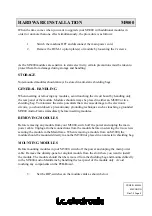
Step 1
When the image is aligned and focused, press the button on the joystick to capture the image.
• If the first step fails, clean the front surface of the glass spheres on the
Test Eye
with a soft cloth and
repeat the first step
(Figure 4).
Residual dirt or oil may cause failure.
• If the first step fails after cleaning the test eye, call a ZEISS Technical Support Engineer for further assistance.
Step 2
Continue to align, focus and capture the second sphere (center sphere), when prompted.
Step 3
Capture the third and final sphere (sphere on the right end of the Test Eye).
• When you have finished the steps of capturing images for all three spheres on the test eye, a dialog
appears
(Figure 5)
showing the final results of the complete calibration test.
• Three
PASS
reports indicate successful calibration with accurate measurement reading of the Test Eye.
• If a
FAIL
is reported on one or more of the calibration checks, try cleaning the failed sphere with a soft
cloth and repeating the three step process before calling a ZEISS Technical Support Engineer. If needed, you
may order a new calibration tool by contacting ZEISS and asking for a Test Eye (PN 000000-109-4714).
Page 2 of 2
How can I perform a calibration test on my ATLAS 9000? |
ZEISS Quick Help: ATLAS
®
9000
Figure 4
SER.8367
Printed in the USA CZ
-XI/MMXVI
The contents of this r
efer
ence guide may d
iffer fr
om the curr
ent status of the pr
oduct in your country
. Please contact your r
egional r
epr
esentative for mor
e information. Subject to change in design and scope of
delivery and as a r
esult of ongoing technical developmen
t. A
TLAS is either a tr
ademark or r
egister
ed
trademark of Carl Zeiss Med
itec, Inc. in the United S
tates and/or other countries.
© 2016 Carl Zeiss Med
itec, Inc. Al
l copyrights r
eserved.
Carl Zeiss Meditec Inc.
5160 Hacienda Drive
Dublin, CA 94568
USA
www.zeiss.com/med
Carl Zeiss Meditec AG
Goeschwitzer Str. 51-52
07745 Jena
Germany
www.zeiss.com/med
0297
Refer to the ATLAS 9000 user manual
Instructions for Use
for safe and effective operation of the instrument.
Figure 5




















